Promoting Workplace Wellness Boosts Your Bottom Line. Here’s How to Harness the Power of Wellbeing.
Last Updated Jul 3, 2025

Wellness isn't a perk—it's a power move.
Today’s top talent is looking for more than a paycheck. They’re looking for purpose, balance, and employers who care about the whole person. And they’re making decisions accordingly. Eighty-three percent say they’d consider leaving a company that overlooks employee wellbeing.
Forward-thinking HR leaders are taking advantage of this opportunity. They’re turning wellness into a competitive edge, watching turnover drop, productivity rise, and culture thrive. The return on investment? Real, measurable, and business-changing.
Discover how strategic wellness keeps your best people energized, engaged, and all in.
What You'll Learn
- Wellness Is a Strategic Business Imperative: Prioritizing employee wellbeing leads to lower turnover, higher productivity, and reduced healthcare costs—making wellness not just a perk, but a measurable competitive advantage.
- Whole-Person Support Drives Engagement and Retention: Holistic wellness programs that address physical health, mental wellbeing, and work-life flexibility result in happier, more loyal employees who feel seen and supported.
- Effective Wellness Initiatives Are Inclusive and Actionable: From hydration challenges to virtual workshops and standing desk programs, practical wellness activations can be easily adapted for both remote and in-office teams.
- Sustained Engagement Requires Smart Communication and Incentives: Wellness initiatives succeed when they are clearly communicated, gamified, incentivized, and celebrated—encouraging consistent participation across the organization.
- Culture Change Starts with Leadership and Policy: Long-term impact comes from visible leadership, wellness-centered policies, and continuous feedback loops that reinforce a thriving, people-first company culture.
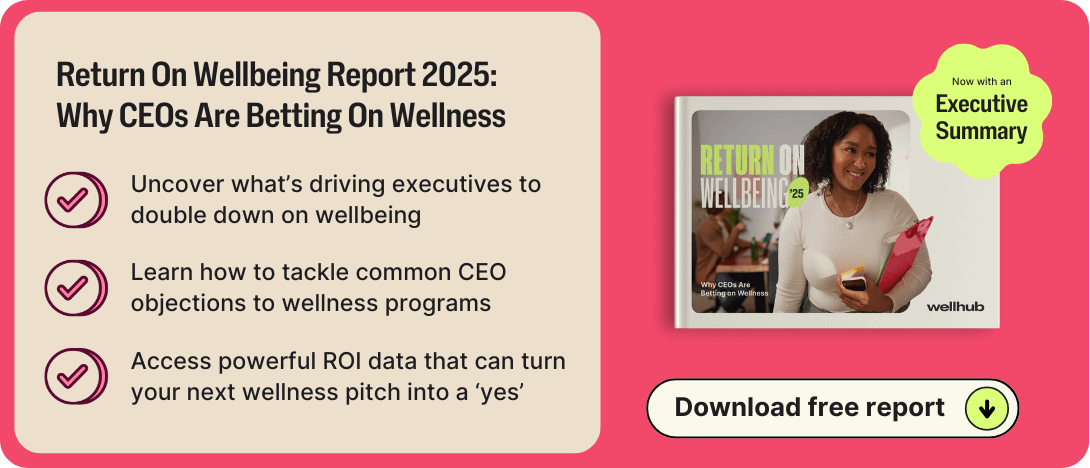
The Business Case for Wellness
Burnout is draining your bottom line. Today’s employees are overextended, under-rested, and actively rethinking what they need from work. In fact, 83% of employees say they’d consider leaving a company that does not focus on employee wellbeing.
That’s more than a workforce trend—it’s a flashing neon sign for HR leaders. Promoting wellness in the workplace isn’t just about perks. It’s about protecting productivity, reducing turnover, and meeting your team where they are mentally and physically.
And here’s the kicker: when you invest in wellness, the return is real. More than half of companies get $2 back for every $1 they invest in their wellness program. That’s more than a correlation—it’s a competitive advantage.
Let’s break it down:
- Wellness reduces turnover. Nearly all HR leaders (98%) say their wellness program has helped reduce employee turnover. And with the average cost of replacing an employee sitting anywhere from one-half to two times their salary, that’s a cost you want to avoid.
- Wellness boosts productivity. Burned-out employees are 20% less productive—and that costs the U.S. economy an estimated $234 billion annually. But when wellbeing is a priority? Ninety-nine percent of HR leaders say they see a productivity boost, and nearly half say that improvement is major.
- Wellness improves retention and engagement. Sixty-one percent of workers with wellness benefits report being happy at their current company, compared to just 36% of those without. That’s nearly double the workplace happiness, and that joy pays dividends in loyalty, morale, and performance.
- Wellness lowers healthcare costs. Preventative care pays off. Nine in ten companies report lower healthcare costs thanks to their wellness program, with 24% seeing major savings.
If you’ve ever questioned whether wellness belongs on your strategic agenda, here’s your answer: it does. When you promote wellness in the workplace, you’re not just supporting your people—you’re investing in the long-term health of your business.

How to Support the Whole Employee
Promoting wellness in the workplace means caring for the whole person—not just their output. That means supporting physical health, mental wellness, and work-life balance in ways that feel personalized, accessible, and real.
Let’s break down what that looks like in action:
Physical Health: Make Movement Easy
Most employees want to move more, but 56% say time constraints keep them from exercising. That means your job isn’t just to encourage fitness. It’s to make it convenient.
Simple shifts can make a big difference:
- Offer standing desks or adjustable workstations to support posture and mobility.
- Bring fitness on-site or online with subsidized gym memberships, access to on-demand classes, or programs like Wellhub that offer both.
- Host wellness challenges like step-count competitions or hydration goals that spark engagement without pressure.
When movement is built into the workday, physical wellness becomes a habit—not a hassle.
Mental Wellness: Normalize Support
Work stress is the leading cause of emotional health issues, according to 47% of employees. That’s your cue to make mental wellness a cultural norm, not a taboo topic.
Try these ideas:
- Provide access to mindfulness tools, like guided meditation apps, quiet spaces, or group sessions.
- Offer therapy stipends or EAPs (employee assistance programs) to reduce the financial burden of counseling.
- Train managers to recognize signs of burnout and respond with empathy, not just performance metrics.
And remember: 75% of employees with Wellhub say their mental wellbeing improved in the last year compared to 43% without it. Support works—when it’s visible, consistent, and stigma-free.
Work-Life Wellness: Build in Flexibility
When employees can take care of life without hiding it, they show up stronger at work.
Here’s how to help:
- Offer flexible hours or core working windows to give teams more control over their time.
- Normalize screen breaks and discourage back-to-back meetings. (Yes, even in leadership!)
- Encourage PTO—and celebrate when people use it. A rested team is a more resilient one.
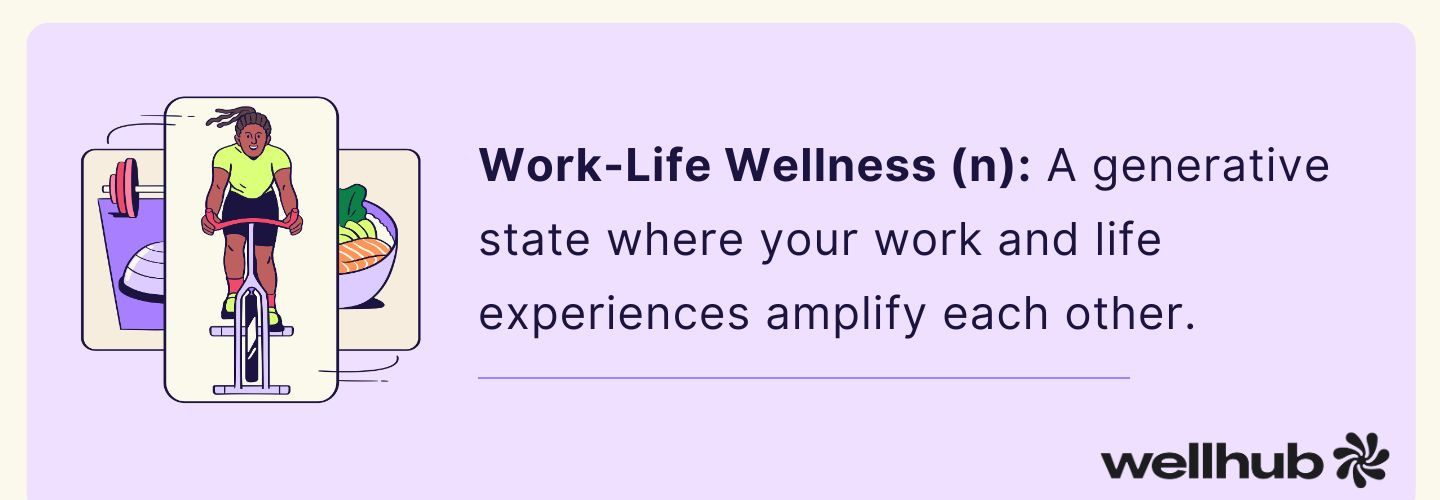
8 Activation Ideas for Promoting Workplace Wellness
You don’t need to rebuild your entire HR strategy to promote wellness in the workplace. You just need to start with intention.
These eight activation ideas are designed to support both in-office and remote teams, making wellness accessible to everyone, everywhere.
- Launch a Wellness Reimbursement Program
What it is: A monthly or quarterly stipend employees can use for health and wellness expenses—like gym memberships, ergonomic gear, or therapy sessions.
How to activate it:
- Set your reimbursement cap (e.g., $50/month per employee).
- Define eligible expenses across all dimensions of wellness (physical, emotional, nutritional, etc.).
- Use an easy reimbursement system—many payroll platforms have built-in tools.
Remote ready: Employees can apply funds toward home gym equipment, virtual workouts, or digital wellness apps.
- Create a Mindful Monday Ritual
What it is: A short, weekly opportunity to start the week with calm and clarity—think five-minute breathwork, gratitude journaling, or a short guided meditation.
How to activate it:
- Host live sessions via Zoom or Teams every Monday morning.
- Use recordings or rotating prompts for asynchronous participation.
- Invite guest facilitators—or use mindfulness platforms your team already loves.
Remote ready: Employees can join live from anywhere or access replays on demand.
- Start a Standing Desk Program
What it is: Encourage movement by supporting better home and office ergonomics.
How to activate it:
- Offer a one-time stipend for standing desks or desk converters.
- Share best-in-class ergonomic setups for various budgets.
- Consider a “try before you buy” program with sample equipment for onsite teams.
Remote ready: Apply the same stipend to remote workers for home-office upgrades.
- Host a Hydration Challenge
What it is: A team-based or solo challenge to increase daily water intake and build healthier habits.
How to activate it:
- Choose a platform (like Slack or a wellness app) to track progress.
- Provide branded water bottles or digital leaderboards.
- Celebrate winners with shoutouts or small prizes.
Remote ready: Use online tracking forms or hydration reminders delivered by app or email.
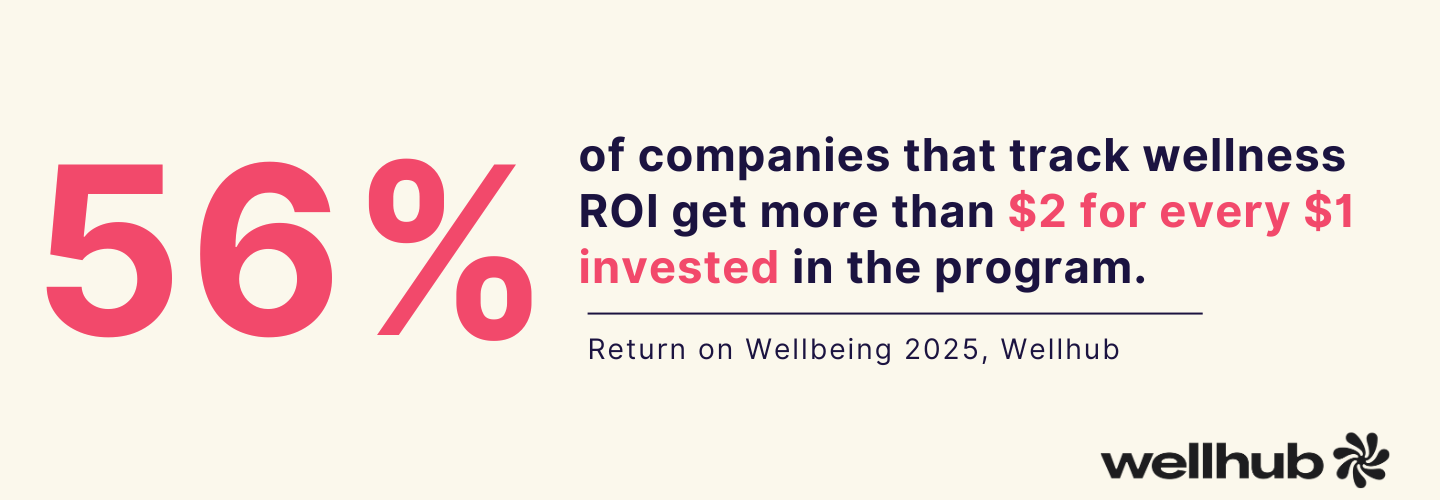
- Integrate “Focus Hours” Into Team Calendars
What it is: Company-wide or team-wide blocks of protected time for deep work—no meetings, no pings, no interruptions.
How to activate it:
- Pick two recurring time slots per week (e.g., 9–11 a.m. Tuesdays and Thursdays).
- Train managers to model and respect focus time.
- Combine with calendar nudges or Slack statuses like “In Focus Mode.”
Remote ready: Reinforce asynchronous work norms and empower people to set their own protected hours.
- Offer Virtual Wellness Workshops
What it is: Quick, high-impact sessions like “Stretch at Your Desk,” “Meal Prep 101,” or “Stress-Busting Breathwork.”
How to activate it:
- Host live workshops monthly via Zoom.
- Record each session and build a searchable wellness content hub.
- Rotate topics based on employee feedback and wellness trends.
Remote ready: Design for virtual delivery first, inviting onsite employees to join online, too.
- Embed Wellness into Manager 1:1s
What it is: Make wellness part of the conversation—not a separate “program.”
How to activate it:
- Train managers to ask one simple question: “How’s your wellbeing right now?”
- Provide a guide with helpful follow-ups and signs of burnout.
- Share resources they can recommend with confidence—like EAPs or wellness benefits.
Remote ready: Managers of distributed teams should make wellness check-ins a consistent, low-pressure part of every virtual one-on-one.
- Offer Healthy Food Options at the Office
What it is: Help employees nourish their bodies with healthy, energizing food options.
How to activate it:
- Stock break rooms with nutrient-rich snacks and hydration options.
- Partner with local vendors or meal delivery services for healthy options.
- Offer meal kit stipends or grocery delivery credits for remote staff.
Remote ready: Let remote workers choose their own delivery app or meal service; just offer a set budget they can use monthly.

How to Engage Employees in Wellness Initiatives
Even the best wellness ideas fall flat without one thing: engagement. Whether you're introducing a hydration challenge, rolling out new meditation tools, or encouraging flexible focus hours, your success hinges on employee participation. This step-by-step action plan helps you turn great ideas into workplace habits—so wellness becomes something employees want to engage with, not just something HR recommends.
Step 1: Define Your Focus and Set a Clear Goal
Before launching any wellness initiative, choose one focus area—like movement, mindfulness, or nutrition. Then set a specific, achievable goal that makes it easy for employees to understand what they’re working toward.
For example:
- “Drink 64 oz. of water every day for two weeks.”
- “Try three guided meditation sessions this month.”
- “Take one 10-minute standing break each morning.”
Communicate this goal in plain language, and explain how it contributes to wellbeing.
Why this matters: A clear focus prevents initiative fatigue and gives employees a sense of purpose. People are more likely to participate when they know exactly what to do—and why it matters.
Step 2: Choose the Right Communication Channels
To drive participation, you need to show up in the spaces your employees already use. Promote your wellness initiative across multiple internal communication channels:
- Pin announcements in Slack or Microsoft Teams.
- Add banners to your intranet homepage.
- Include a wellness spotlight in your weekly team updates.
- Post visual reminders in office kitchens or break rooms.
Designate a #wellness Slack channel (or equivalent) where you can post prompts, cheer people on, and collect wins.
Why this matters: Repetition builds recognition. Using familiar tools keeps wellness top of mind and prevents your efforts from getting lost in inboxes or overlooked in meetings.
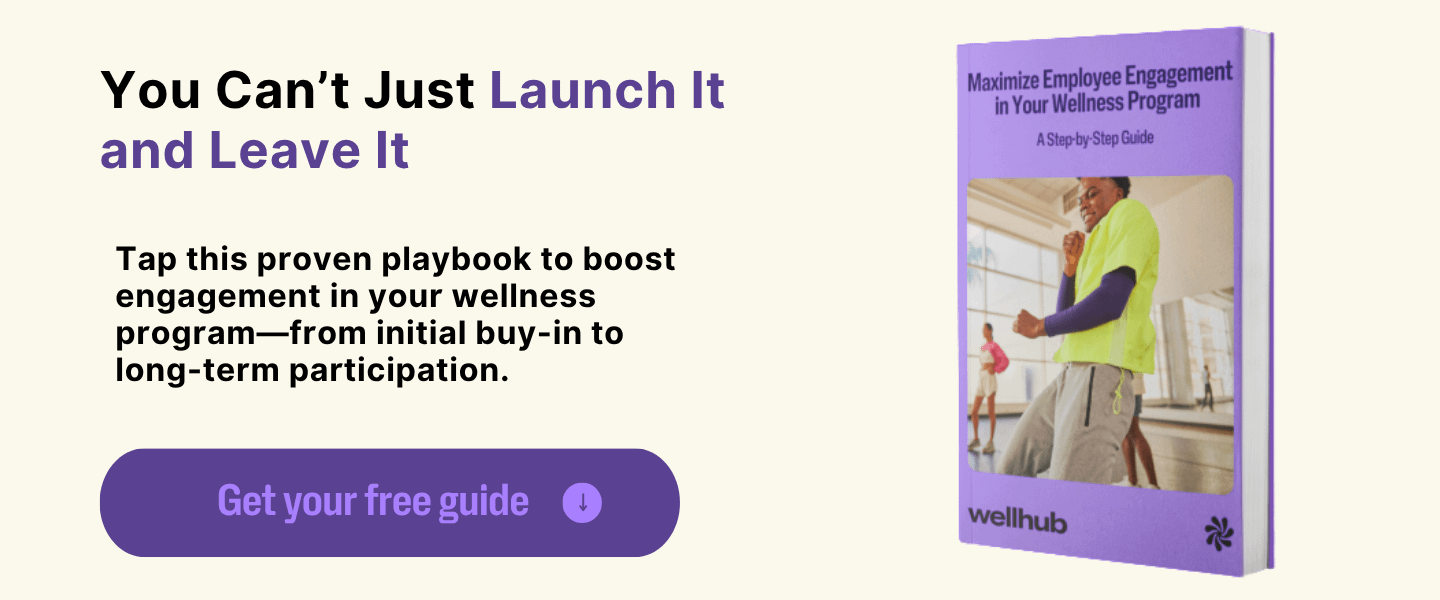
Step 3: Gamify the Experience
Friendly competition can supercharge engagement. Gamification makes wellness fun and gives people a reason to keep showing up. Use points systems, badges, or progress bars to create a sense of accomplishment.
Try:
- Awarding daily points for completing the habit (e.g., 10 points for each water log).
- Sharing leaderboards (weekly, not daily—to reduce pressure).
- Unlocking digital wellness badges for milestones (like “Hydration Hero” or “Stretch Champion”).
Relevant Tools: Wellhub's Challenges feature, Bonusly, Motivosity, or a simple Google Sheet leaderboard.
Why this matters: Recognition is a motivator. Gamification adds structure and energy to otherwise small, easy-to-skip wellness moments.
Step 4: Offer Light but Meaningful Incentives
Wellness doesn’t have to come with big rewards, but small tokens of appreciation go a long way. A little incentive makes the initiative feel special and worth the effort.
Ideas include:
- A raffle entry for each day someone logs their wellness action.
- Branded swag (like water bottles, yoga mats, or gratitude journals).
- Wellness-related gift cards (e.g., Calm, DoorDash, or Whole Foods).
Keep the focus on intrinsic motivation—supporting wellbeing for wellbeing’s sake—but let incentives sweeten the deal.
Why this matters: When employees feel like their effort is noticed, they’re more likely to stay engaged. Rewards show that you value not just outcomes—but participation.
Step 5: Celebrate Wins—Big and Small
Build momentum by celebrating progress. Spotlight participation during team meetings or in internal newsletters. Share photos, quotes, or anonymous stats to highlight community engagement.
Try:
- A “Wellness Wall of Fame” with names or photos of participants.
- Quotes from employees on how the initiative impacted their day.
- A shoutout of the week for someone who went above and beyond.
Why this matters: Recognition reinforces that wellness is a shared value—not a solo pursuit. Celebrations create community and sustain interest.

Step 6: Make It Easy to Participate from Anywhere
Wellness should be equally accessible for remote, hybrid, and on-site employees. Build your initiative to be location-flexible from the start.
Examples:
- Use digital tools like Google Forms, Slack bots, or wellness apps for tracking.
- Offer virtual options (e.g., Zoom stretch breaks or recorded meditation sessions).
- Let employees post updates asynchronously, not just live.
Why this matters: Equitable access drives equitable participation. Remote employees are more likely to engage when the experience doesn’t rely on being physically present.
How to Make a Long-Term Culture of Wellness
Launching a hydration challenge or sharing mindfulness tips is a great start, but real impact happens when wellness becomes woven into the way your company works. A lasting culture of wellness doesn’t rely on individual initiatives. It grows from consistent action, visible leadership, and a deep belief that employee wellbeing fuels business success.
Here’s how to build that foundation:
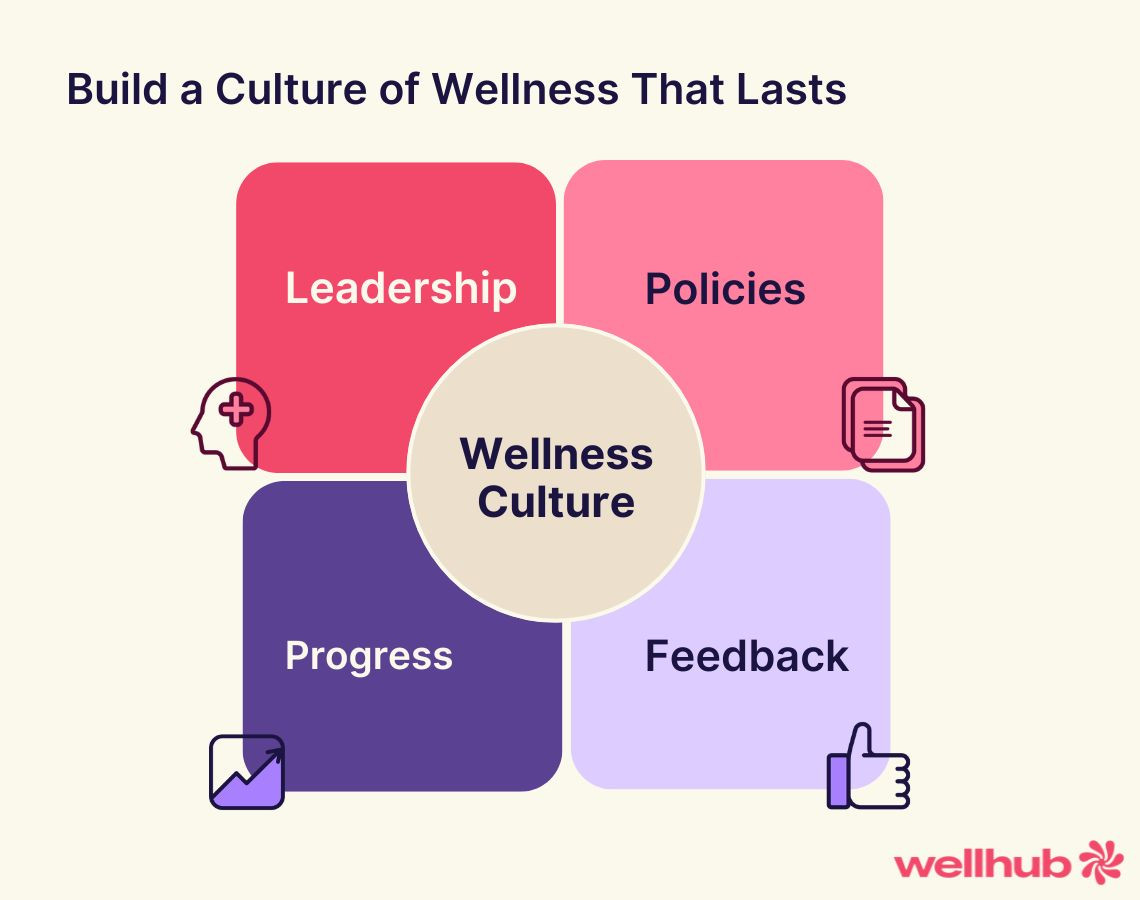
Make Leadership Visible
When executives and managers model healthy habits, it signals that wellness isn’t just permitted—it’s expected. When leaders show up, employees follow. And the impact is measurable: higher rates of C-suite engagement drive higher rates of employee engagement in wellness programs.
This isn’t about grand gestures. When a VP blocks time for a midday workout or a manager publicly celebrates participation in a hydration challenge, they’re sending a clear message: wellness matters here.
How to start: Ask leaders to join wellness challenges, speak candidly about their wellbeing routines in all-hands meetings, or co-host virtual mindfulness sessions.
Bake Wellness Into Policies and Norms
Supportive culture starts with structure. That means reviewing existing policies to make sure they reinforce—not contradict—your wellness values.
How to start:
- Embed wellness questions into employee engagement surveys.
- Add “wellbeing check-ins” to one-on-one templates.
- Formalize break policies, flexible hours, and meeting-free focus times.
Even better? Give wellness its own budget line in annual planning. It shows long-term commitment—and enables long-term results: CEOs who still think wellness is a cost are more likely to see these programs budgeted for as a separate line item (39% vs. 28%).
Build Feedback Loops That Keep You Aligned
A thriving culture is a responsive one. Ask your team what’s working, what isn’t, and what they wish they had. Wellness needs shift over time. Your culture should, too.
How to start:
- Send short pulse surveys after each initiative.
- Host quarterly wellness roundtables or listening sessions.
- Use data to iterate—not just celebrate.
Transparency about what you hear and how you respond builds credibility—and momentum.
Celebrate Progress Over Perfection
You don’t need to roll out every benefit at once. You just need to keep moving forward. Small changes add up when they’re consistent and aligned with your company’s values.
How to start: Mark wellness milestones in company meetings or newsletters. Highlight employee stories. Share metrics, but always tie them back to people to these numbers come to life.
Protect Performance and Retention by Promoting Wellness in the Workplace
Burnout, disengagement, and rising turnover are clear signs your workplace isn’t meeting employee needs. When people don’t feel supported, productivity drops—and so does loyalty. Promoting wellness in the workplace helps prevent that spiral.
A strong wellbeing program makes support easy, visible, and personal. It helps people recharge mentally and physically, which boosts focus and morale. Companies that work with Wellhub to support wellness in the workplace see up to 30% lower turnover and save up to 35% on healthcare costs. Now that’s just good business.
Speak with a Wellhub Wellbeing Specialist to support wellness in your workplace!

Company healthcare costs drop by up to 35% with Wellhub*
See how we can help you reduce your healthcare spending.
References:
- Paid Sick Days Are Good for Business: Fact Sheet. (2023). https://nationalpartnership.org/wp-content/uploads/2023/02/paid-sick-days-good-for-business-and-workers.pdf
- Wellhub (2024, October 16). The State of Work-Life Wellness 2025. https://wellhub.com/en-us/resources/research/work-life-wellness-report-2025/
- Wellhub (2024, May 16). Return on Wellbeing 2024. https://wellhub.com/en-us/resources/research/return-on-wellbeing-2024/
- Wellhub. (2023, October 18). The State of Work-Life Wellness 2024. https://wellhub.com/en-us/resources/research/work-life-wellness-report-2024/
Category
Share

The Wellhub Editorial Team empowers HR leaders to support worker wellbeing. Our original research, trend analyses, and helpful how-tos provide the tools they need to improve workforce wellness in today's fast-shifting professional landscape.
Subscribe
Our weekly newsletter is your source of education and inspiration to help you create a corporate wellness program that actually matters.
Subscribe
Our weekly newsletter is your source of education and inspiration to help you create a corporate wellness program that actually matters.
You May Also Like

The Seven Most Important Employee Engagement Trends of 2024
Wellhub asked more than 5,000 workers what they need to thrive. Here’s what their responses can teach HR about maximizing employee engagement.

Improve Quality of Life at Work: An HR Roadmap | Wellhub
Boost engagement, retention, and performance with proven HR strategies that elevate employee wellbeing and create a thriving workplace culture.

Workplace Wellness Strategies a Strong ROI | Wellhub
Cut burnout, boost morale, and win executive buy-in with a wellness strategy that drives real business outcomes.